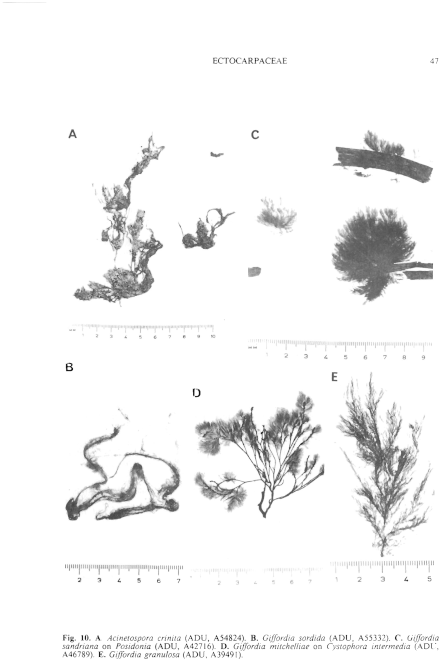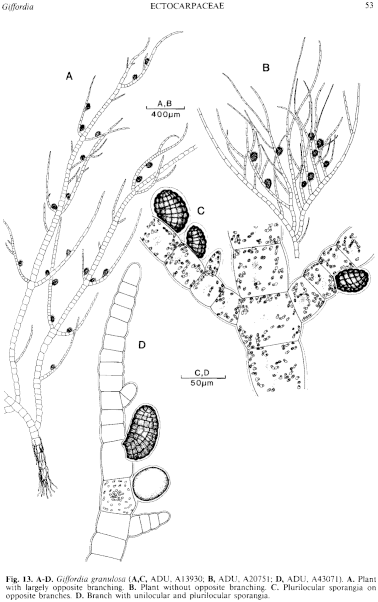|
|
|
|
|
|||||||||||
|
Electronic Flora of South Australia Species Fact Sheet
Phylum Phaeophyta – Order Ectocarpales
Selected citations: Cardinal 1964: 39, figs 19, 20. Clayton 1974: 770, figs 15, 16. King & Ducker 1971: 115. Kornmann & Sahling 1977: 109, fig. 55. Kuckuck 1961: 119, figs 1–9. Womersley 1967: 192.
Synonym
G. secunda sensu Womersley 1967: 193.
Thallus (Fig. 10E) medium to dark brown, usually densely tufted and 0.5–2 (–10) cm high, with one to several axes attached by descending rhizoids (which often surround the axis) from few to many cells above the base, much branched (especially above) with frequent to occasional opposite branches (Fig. 13A) as well as spirally or largely unilaterally arranged branchlets (Fig. 13B); usually epiphytic. Filaments (Fig. 13A,B) tapering markedly between base and apices, 30–80 µm in diameter below (slenderer near the very base) with cells L/B (0.5–) 1–2, mid branches 40–60 µm in diameter with cells L/B (0.5–) 1–1.5 (–2), lesser branchlets 20–30 (–40) µm in diameter with cells L/B (0.3–) 0.5–1, tapering, straight to reflexed and with short end cells when young, with long slender false hairs 8–12 (–20) µm in diameter when mature. Growth mainly from meristems at the base of each branch, also with scattered intercalary divisions. Cells (Fig. 13C) with numerous discoid phaeoplasts each with a pyrenoid, and centrally clustered physodes.
Reproduction: Plurilocular sporangia (Fig. 13C) sessile, single, usually unilaterally and adaxially arranged, conical to ovoid and broadest near their base, asymmetrical and upwardly curved or lying adjacent to the branch, 50–100 µm long and 25–70 µm in diameter when mature, L/B usually 1–1.5 (–2). Unilocular sporangia (Fig. 13D) rare, on plants also bearing plurilocular sporangia, sessile, ovoid, 50–80 µm long and 35–55 µm in diameter.
Type from England; not located (Clayton 1974, p. 772).
Selected specimens: Elliston, S. Aust., on Dictyota diemensis in sublittoral pools (Womersley, 15.i.1951; ADU, A13930). Sandy R. mouth, Kangaroo I., S. Aust., lower eulittoral ( Womersley, 5.ii.1957; ADU, A55518). Pennington Bay, Kangaroo I., S. Aust., sublittoral fringe, epiphytic (Womersley, 31.xii.1949; ADU, A50539). Robe, S. Aust., drift on Dictyopteris muelleri (Womersley, 16.v.1965; ADU, A29267). Bridgewater Bay, Vic., on Pyura in pools (Womersley, 28.i.1964; ADU, A27435). Apollo Bay, Vic. 0.5 m deep on pipeline in harbour (Owen, 1.ix.1971; ADU, A39491-"Marine Algae of southern Australia" No. 30). Kirk Point, Port Phillip, Vic. (Clayton, 30.viii.1971; MELU, 21138, ADU, A43071). Remine (Trial Harbour), Tas., on Halopteris in reef pools ( Wollaston & Mitchell, 25.ii.1964; ADU, A29298).
Distribution: Widely distributed in temperate seas.
In southern Australia, from Elliston, S. Aust., to Mallacoota, Vic. and the west coast of Tasmania.
Taxonomic notes: Womersley (1967, p. 193) recorded G. secunda (Kützing) Batters from southern Australia, but Clayton (1974, p. 773) has referred these specimens to G. granulosa since they do not possess two types of plurilocular organs as in G. secunda (Sauvageau 1896b, p. 388). Their branching is largely alternate without opposite branches, but such forms do occur in G. granulosa (Kuckuck 1961, figs 3–9).
References:
CARDINAL, A. (1964). Étude sur les Ectocarpacees de la Manche. Nova Hedwigia 15, 1–86, Figs. 1–41.
CLAYTON, M.N. (1974). Studies on the development, life history and taxonomy of the Ectocarpales (Phaeophyta) in southern Australia. Aust. J. Bot. 22, 743–813.
HAMEL, G. (1939b). Phéophycées de France. Fasc. V, pp. 337–432, i-xlvii. (Paris.)
KING, R.J. & DUCKER, S. (1971). In King, R.J., Black, J.H. & Ducker, S. Intertidal ecology of Port Phillip Bay, with systematic lists of plants and animals. 3. Flora of the intertidal region, pp. 112–128. Mem. Nat. Mus. Vic. 32, 93–128.
KORNMANN, P. & SAHLING, P.-H. (1977). Meeresalgen von Helgoland. Benthische Braun und Rotalgen. Helgol. wiss. Meeresunters. 29, 1–292.
KUCKUCK, P. (1961). Herausgegeben von P. Kornmann. Ectocarpaceen-Studien VII. Giffordia. Helgol. wiss. Meeresunters. 8, 119–152.
SAUVAGEAU, C. (1896b). Observations relatives à la sexualité des Phéosporées. I de Bot. 10, 357–367, 388–398.
WOMERSLEY, H.B.S. (1967). A critical survey of the marine algae of southern Australia. II. Phaeophyta. Aust. J. Bot. 15, 189–270.
The Marine Benthic Flora of Southern Australia Part II complete list of references.
Publication:
Womersley, H.B.S. (14 December, 1987)
The Marine Benthic Flora of Southern Australia
Part II
©Board of the Botanic Gardens and State Herbarium, Government of South Australia
Illustrations in Womersley Part II, 1997: FIGS 10E, 13 A–D.

Figure 10 enlarge
Fig. 10. A. Acinetospora crinita (ADU, A54824). B. Giffordia sordida (ADU, A55332). C. Giffordia sandriana on Posidonia (ADU, A42716). D. Giffordia mitchelliae on Cystophora intermedia (ADU, A46789). E. Giffordia granulosa (ADU, A39491).

Figure 13 enlarge
Fig. 13. A–D. Giffordia granulosa (A,C, ADU, A13930; B, ADU, A20751; D, ADU, A43071). A. Plant with largely opposite branching. B. Plant without opposite branching. C. Plurilocular sporangia on opposite branches. D. Branch with unilocular and plurilocular sporangia.

|
Email Contact: State Herbarium of South Australia |

|